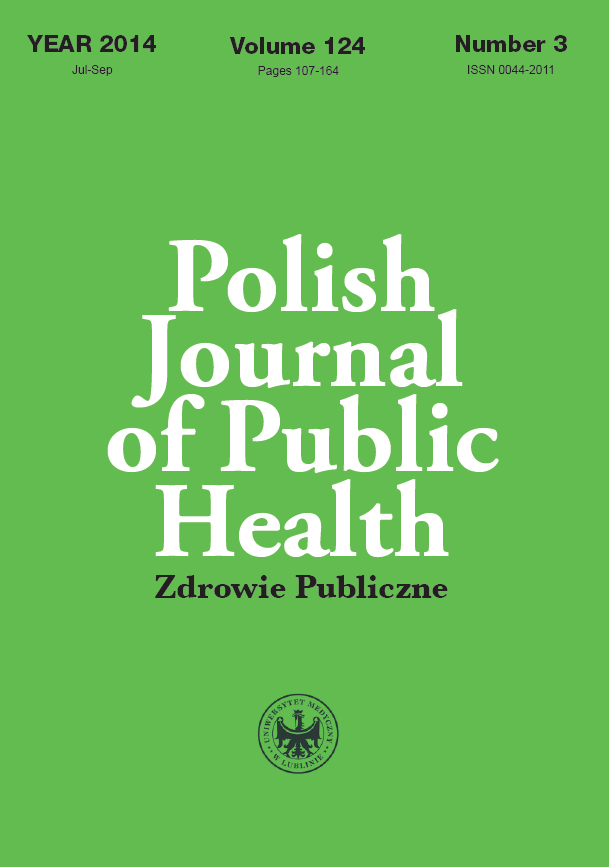Quality of life and sleep disorders among patients treated with hemodialysis in relation to dialysis adequacy
DOI:
https://doi.org/10.2478/pjph-2014-0025Słowa kluczowe:
quality of life, sleep disorders, end stage renal disease, hemodialysisAbstrakt
Introduction. Recent studies in this field are insufficient to determine the relationship between life quality and hemodialysis adequacy. The problem, which requires further analysis is the issue of verification of these relationships and the problem of the relationship between sleep disorders and hemodialysis indicators.
Aim. The aim of this study is to determine the relationship between quality of life and sleep disorders occurring among patients with end stage renal disease (ESRD) treated with hemodialysis and the dialysis adequacy parameters.
Material and methods. The survey was based on two standardized international scales: the Quality of Life Scale (SF-36) and the Pittsburg Sleep Quality Index (PSQI). The study was conducted among 150 patients (67 women and 83 men) treated with hemodialysis at the Fresenius center. All patients participating in the study were undergoing dialysis three times a week. The average value of Kt/V was 1.45 (SD=0.22) and URR ration 71.78 (SD=5.95).
Results. The urea level prior to hemodialysis moderately strongly correlates with life energy deficit (r=-0.34, p=-0.049) and that the values of urea reduction ratio URR weakly correlates with the patient’s conviction on restricting life’s activity (SF-36) (r=0.18, p=0.046). The level of urea prior to dialysis correlates positively with the time of falling asleep in PSQI scale (r=-0.39, p=0.023).
Conclusions. Patients with lower urea level before hemodialysis have a significantly higher vitality level. Higher fluctuations of urea concentrations before and after hemodialysis (higher urea reduction ratio URR) are associated with restrictions of physical activity in hemodialysis patients.
Bibliografia
1. Yarlas AS, White MK, Yang M, Saris-Baglama RN, Bech PG, Christensen T. Measuring the health status burden in hemodialysis patients using the SF-36® health survey. Qual Life Res. 2011;20(3):383-9. doi: 10.1007/s11136-010-9764-8.
2. Fujisawa M, Ichikawa Y, Yoshiya K, et al. Assessment of health-related quality of life in renal transplant and hemodialysis patients using the SF-36 health survey. Urology. 2000;56(2):201-6.
3. Einollahi B, Motalebi M. Gender effect on quality of life in hemodialysis patients. J Nephrol. 2013 Dec 6. [Epub ahead of print].
4. dos Santos AC, Machado Mdo C, Pereira LR, Abreu JL, Lyra MB. Association between the level of quality of life and nutritional status in patients undergoing chronic renal hemodialysis. J Bras Nefrol. 2013;35(4):279-88. doi: 10.5935/0101-2800.20130047.
5. Md Yusop NB, Yoke Mun C, Shariff ZM, Beng Huat C. Factors associated with quality of life among hemodialysis patients in Malaysia. PLoS One. 2013;8(12):e84152. doi: 10.1371/journal.pone.0084152.
6. Martinson M, Ikizler TA, Morrell G, et al. Associations of Body Size and Body Composition with Functional Ability and Quality of Life in Hemodialysis Patients. Clin J Am Soc Nephrol. 2014 Apr 24. [Epub ahead of print]
7. Iliescu EA, Coo H, McMurray MH, et al. Quality of sleep and health-related quality of life in haemodialysis patients. Nephrol Dial Transplant. 2003;18(1):126-32.
8. Bilgic A, Akgul A, Sezer S, et al. Nutritional status and depression, sleep disorder, and quality of life in hemodialysis patients. J Ren Nutr. 2007;17(6):381-8.
9. Edalat-Nejad M, Qlich-Khani M. Quality of life and sleep in hemodialysis patients. Saudi J Kidney Dis Transpl. 2013;24(3):514-8.
10. Turkmen K, Erdur FM, Guney I, et al. Sleep quality, depression, and quality of life in elderly hemodialysis patients. Int J Nephrol Renovasc Dis. 2012;5:135-42. doi: 10.2147/IJNRD.S36493.
11. Dwyer JT, Larive B, Leung J, et al. Hemodialysis Study Group. Nutritional status affects quality of life in Hemodialysis (HEMO) Study patients at baseline. J Ren Nutr. 2002;12(4):213-23.
12. Unruh M, Benz R, Greene T, et al. HEMO Study Group HEMO Study Group: effects of hemodialysis dose and membrane flux on health related quality of life in the HEMO Study. Kidney International 2004;66:355-66.
13. Spiegel BM, Melmed G, Robbins S, Esrailian E. Biomarkers and health-related quality of life in end-stage renal disease: a systematic review. Clin J Am Soc Nephrol. 2008;3(6):1759-68. doi: 10.2215/CJN.00820208.
14. Abdelwhab S, Kamel M, Noshey M. Sleep Disorders in Hemodialysis Patients Kidney 2010;19(4):175-81.
15. Kalender N, Tosun N. Determination of the relationship between adequacy of dialysis and quality of life and self-care agency. J Clin Nurs. 2014;23(5-6):820-8. doi: 10.1111/jocn.12208.
16. Tylka J, Piotrowicz R. Kwestionariusz oceny jakości życia SF-36 – wersja polska [Quality of life questionnaire SF-36 – Polish version]. Kardiol Pol. 2009;67(10):1166-9.
17. Buysse DJ, Reynolds CF 3rd, Monk TH, et al. The Pittsburgh Sleep Quality Index: a new instrument for psychiatric practice and research. Psychiatry Res. 1989;28(2):193-213.
18. Daugirdas JT. Second generation logarithmic estimates of single-pool variable volume Kt/V: an analysis of error. J Am Soc Nephrol. 1993;4(5):1205-13.
19. Sułowicz W. Praktyczne aspekty oceny jakości dializoterapii [Practical aspects of dialysis quality assessment]. Forum Nefrolog. 2010;3(3):185-92.


